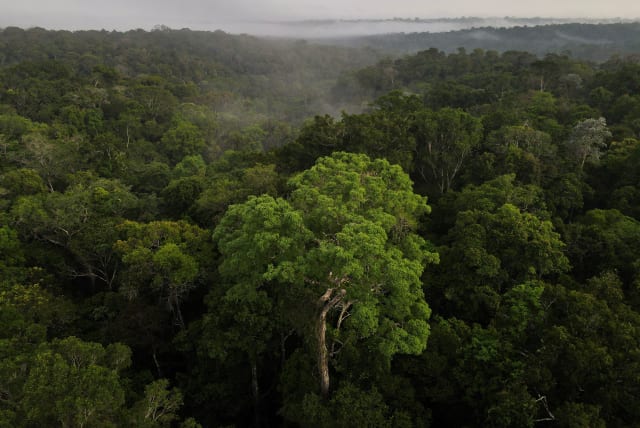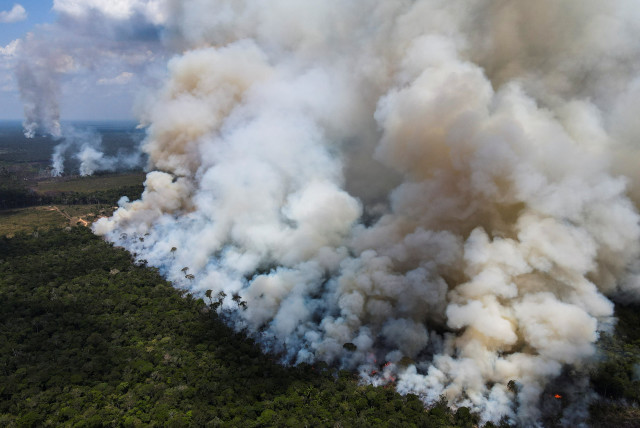Does the secret to forest restoration lie in Amazonian earth? - study

Scientists found that Amazonian soil can help plants grow upto 8.1 times larger.
The Amazonian earth, known as terra preta, is nutrient rich and has a blackened color from years of charcoal additives, a new study has found.
Charcoal from small fires used to cook, animal bones, pottery and compost have enriched, what once was, poor soil quality in the Amazon Forest. The enrichment process took place from 450 BCE to 950 CE, according to a recent study.
Having seen the impact that the soil has on plants' ability to grow, researchers are exploring the possibility that this soil could be the solution to reforestation. A new peer-reviewed study, published in Frontiers in Soil Science, explores such a possibility.
Speeding up reforestation
The researchers collected 3kg of soil samples from the Caldeirão Experimental Research Station in Brazil and a control soil sample from the Luiz de Queiróz Superior School of Agriculture in the state of São Paulo.
The soils’ chemical make-up was analyzed by the scientists. The Amazonian soil, which had a higher PH, had greater concentrations of nutrients than the control soil. More specifically, the Amazonian soil had 30 times more phosporous and 3-5 times more of every other nutrient excluding manganese.
The 3kg soil samples were planted in 36-litre pots and placed in a greenhouse with a mean temperature of 34ºC. The temperature was heightened to simulate future global warming in the Amazon, where the current temperature range tends to fall between 22-28ºC.
One-third of the pots received only the control soil, another third received a mix of the control soil and Amazonian soil in the ratio of 4:1 and the final third consisted entirely of Amazonian soil.
Palisade grass was planted in the pots, a plant chosen for its common use of livestock meal in Brazil. The seedling grew for 60 days, after which the grass was cut and only the roots were allowed to remain. The plants were then replanted with either Ambay pumpwood tree seeds, Peltophorum dubium tree seeds or cendro blanco tree seeds.
Following the planting of tree seeds, the plants were left to germinate for a 90-day period. At the 90-day mark, the trees were measured and assessed for their height, dry mass and root length.
The scientists also reassessed the soil quality at this stage, testing for changes in the soil’s PH, texture and concentration of various organic chemicals. The Amazonian soil still had a higher concentration of nutrients, although both soils had lost some nutrients during the process of plant growth.
Results of the experiment
Amazonian soil proved to help improve plant growth and development. Palisade grass grew 3.4 times more in the mixed soil samples and 8.1 times more in the pure Amazonian soil samples.
“Our data point to a mixture of soil nutrients and adapted microorganisms [in ADE] to improve the establishment of plant trees in restoration,” the researchers wrote.
Additionally, in the cedro blanco and P. dubium tree species, Amazonian soil enabled the treets to grow between 2.1 and 5.2 times taller in the mixed soil. In the pure Amazonian soil, the trees grew between 3.2 to 6.2 times taller. The Ambay plumpwood failed to grow in the control or mixed soil, but successful grew in the Amazonian soil.
The experiment also found that Amazonian soil supported greater bacterial and archaea biodiversity.
“Microbes transform chemical soil particles into nutrients that can be taken up by plants. Our data showed that ADE contains microorganisms that are better at this transformation of soils, thus providing more resources for plant development,” said joint lead author Anderson Santos de Freitas.
“For example, ADE soils contained more beneficial taxa of the bacterial families Paenibacillaceae, Planococcaceae, Micromonosporaceae, and Hyphomicroblaceae.”
“Here we show that the use of [Amazonian earth] can enhance the growth of pasture and trees due to their high levels of nutrients, as well as to the presence of beneficial bacteria and archaea in the soil microbial community,” said joint lead author Luís Felipe Zagatto, a graduate student at the Center for Nuclear Energy in Agriculture of São Paulo University, Brazil. “This means that knowledge of the ‘ingredients’ that make ADEs so very fertile could be applied to help speed up ecological restoration projects.”
However, caution must be taken in using this resource. “ADE has taken thousands of years to accumulate and would take an equal time to regenerate in nature if used. Our recommendations aren’t to utilize ADE itself, but rather to copy its characteristics, particularly its microorganisms, for use in future ecological restoration projects,” warns Dr Siu Mui Tsai, a professor at the same institute.
Why is deforestation an important issue?
Deforestation is a growing concern for many researchers because trees produce a variety of things that humans need for continued survival, like oxygen.
80% of Western Europe was once forested, but now that figure stands at 34% according to the National Geographic Society (NGS). In the United States, half of the forested area in the eastern region was cutdown between 1600-1880 to use the trees’ timber.
Forests are being destroyed to create agricultural land, NGS explains, but this land is only viable for a relatively short period as the soil is drained of nutrients and the land becomes inhospitable to crops. This, in turn, leads to more forests being cut down.
Adding to this environmental concern, trees are often burned during the process of deforestation which releases carbon dioxide into the atmosphere. This accelerates global warming.
The Environment and Climate Change portal is produced in cooperation with the Goldman Sonnenfeldt School of Sustainability and Climate Change at Ben-Gurion University of the Negev. The Jerusalem Post maintains all editorial decisions related to the content.
Jerusalem Post Store
`; document.getElementById("linkPremium").innerHTML = cont; var divWithLink = document.getElementById("premium-link"); if (divWithLink !== null && divWithLink !== 'undefined') { divWithLink.style.border = "solid 1px #cb0f3e"; divWithLink.style.textAlign = "center"; divWithLink.style.marginBottom = "15px"; divWithLink.style.marginTop = "15px"; divWithLink.style.width = "100%"; divWithLink.style.backgroundColor = "#122952"; divWithLink.style.color = "#ffffff"; divWithLink.style.lineHeight = "1.5"; } } (function (v, i) { });

